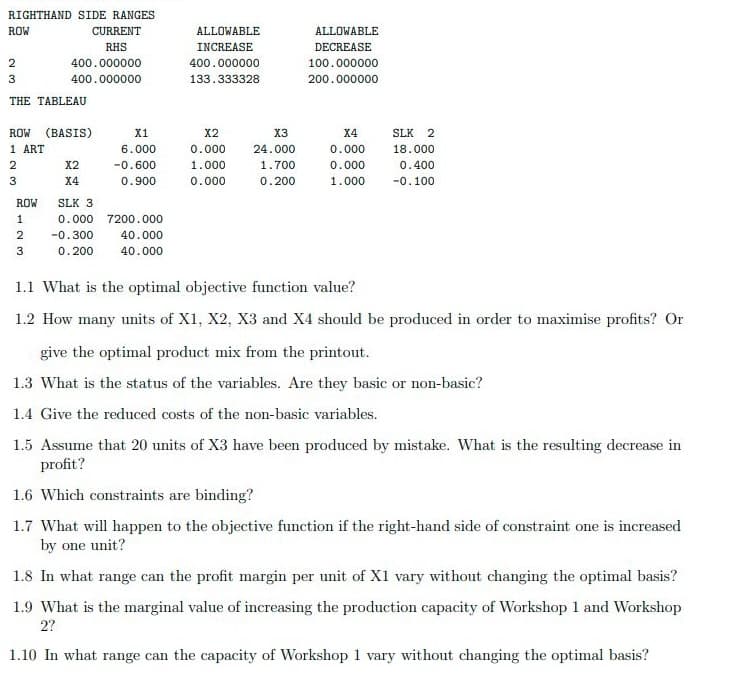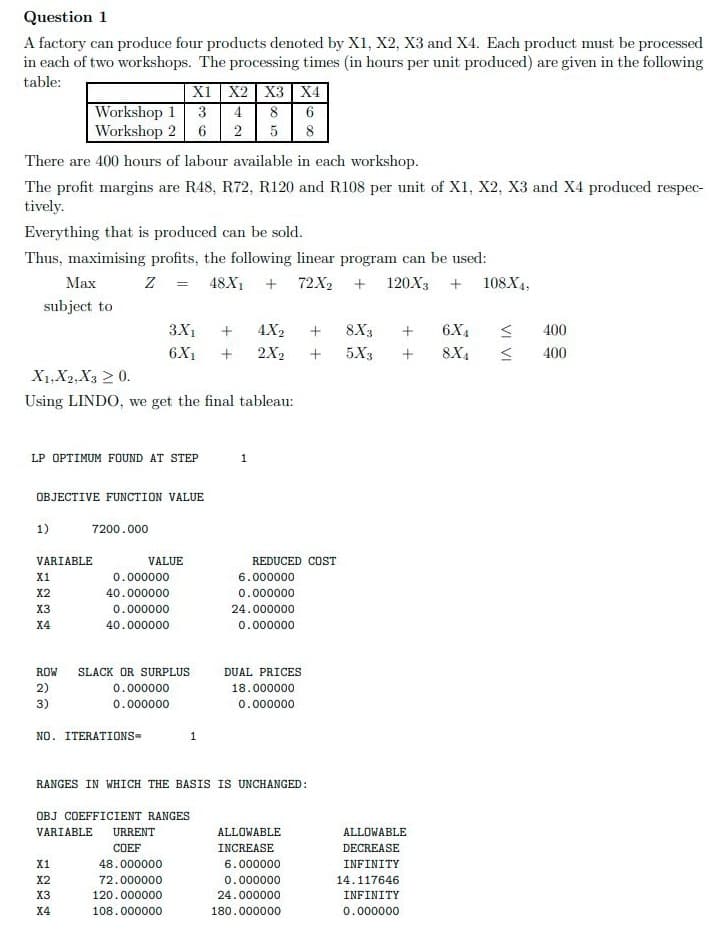RIGHTHAND SIDE RANGES ROW CURRENT ALLOWABLE ALLOWABLE RHS INCREASE DECREASE 2 400.000000 400.000000 100.000000 3 400.000000 133.333328 200.000000 THE TABLEAU ROW (BASIS) X1 X2 X3 X4 SLK 2 1 ART 6.000 0.000 24.000 0.000 18.000 2 X2 -0.600 1.000 1.700 0.000 0.400 3 Х4 0.900 0.000 0.200 1.000 -0.100 ROW SLK 3 0.000 7200.000 2 -0.300 40.000 3 0.200 40.000 1.1 What is the optimal objective function value? 1.2 How many units of X1, X2, X3 and X4 should be produced in order to maximise profits? Or give the optimal product mix from the printout. 1.3 What is the status of the variables. Are they basic or non-basic? 1.4 Give the reduced costs of the non-basic variables. 1.5 Assume that 20 units of X3 have been produced by mistake. What is the resulting decrease in profit? 1.6 Which constraints are binding? 1.7 What will happen to the objective function if the right-hand side of constraint one is increased by one unit? 1.8 In what range can the profit margin per unit of X1 vary without changing the optimal basis? 1.9 What is the marginal value of increasing the production capacity of Workshop 1 and Workshop 2? 1.10 In what range can the capacity of Workshop 1 vary without changing the optimal basis?
RIGHTHAND SIDE RANGES ROW CURRENT ALLOWABLE ALLOWABLE RHS INCREASE DECREASE 2 400.000000 400.000000 100.000000 3 400.000000 133.333328 200.000000 THE TABLEAU ROW (BASIS) X1 X2 X3 X4 SLK 2 1 ART 6.000 0.000 24.000 0.000 18.000 2 X2 -0.600 1.000 1.700 0.000 0.400 3 Х4 0.900 0.000 0.200 1.000 -0.100 ROW SLK 3 0.000 7200.000 2 -0.300 40.000 3 0.200 40.000 1.1 What is the optimal objective function value? 1.2 How many units of X1, X2, X3 and X4 should be produced in order to maximise profits? Or give the optimal product mix from the printout. 1.3 What is the status of the variables. Are they basic or non-basic? 1.4 Give the reduced costs of the non-basic variables. 1.5 Assume that 20 units of X3 have been produced by mistake. What is the resulting decrease in profit? 1.6 Which constraints are binding? 1.7 What will happen to the objective function if the right-hand side of constraint one is increased by one unit? 1.8 In what range can the profit margin per unit of X1 vary without changing the optimal basis? 1.9 What is the marginal value of increasing the production capacity of Workshop 1 and Workshop 2? 1.10 In what range can the capacity of Workshop 1 vary without changing the optimal basis?
Practical Management Science
6th Edition
ISBN:9781337406659
Author:WINSTON, Wayne L.
Publisher:WINSTON, Wayne L.
Chapter5: Network Models
Section5.5: Shortest Path Models
Problem 31P
Related questions
Question

Transcribed Image Text:RIGHTHAND SIDE RANGES
ROW
CURRENT
ALLOWABLE
ALLOWABLE
RHS
INCREASE
DECREASE
2
400.000000
400.000000
100.000000
3
400.000000
133.333328
200.000000
THE TABLEAU
ROW (BASIS)
X1
X2
X3
X4
SLK 2
1 ART
6.000
0.000
24.000
0.000
18.000
X2
-0.600
1.000
1.700
0.000
0.400
3
X4
0.900
0.000
0.200
1.000
-0.100
ROW
SLK 3
0.000 7200.000
2
-0.300
40.000
3
0.200
40.000
1.1 What is the optimal objective function value?
1.2 How many units of X1, X2, X3 and X4 should be produced in order to maximise profits? Or
give the optimal product mix from the printout.
1.3 What is the status of the variables. Are they basic or non-basic?
1.4 Give the reduced costs of the non-basic variables.
1.5 Assume that 20 units of X3 have been produced by mistake. What is the resulting decrease in
profit?
1.6 Which constraints are binding?
1.7 What will happen to the objective function if the right-hand side of constraint one is increased
by one unit?
1.8 In what range can the profit margin per unit of X1 vary without changing the optimal basis?
1.9 What is the marginal value of increasing the production capacity of Workshop 1 and Workshop
2?
1.10 In what range can the capacity of Workshop 1 vary without changing the optimal basis?

Transcribed Image Text:Question 1
A factory can produce four products denoted by X1, X2, X3 and X4. Each product must be processed
in each of two workshops. The processing times (in hours per unit produced) are given in the following
table:
X1 X2 X3 X4
|Workshop 1
Workshop 2
3
4
8
2
5
8
There are 400 hours of labour available in each workshop.
The profit margins are R48, R72, R120 and R108 per unit of X1, X2, X3 and X4 produced respec-
tively.
Everything that is produced can be sold.
Thus, maximising profits, the following linear program can be used:
Маx
Z = 48X1 +
72X2
120X3
108X4,
subject to
3X1
4X2
8X3
6X4
400
6X1
2X2
5X3
8X4
400
X1,X2,X3 2 0.
Using LINDO, we get the final tableau:
LP OPTIMUM FOUND AT STEP
1
OBJECTIVE FUNCTION VALUE
1)
7200.000
VARIABLE
VALUE
REDUCED COST
X1
0.000000
6.000000
X2
40.000000
0.000000
X3
0.000000
24.000000
X4
40.000000
0.000000
ROW
SLACK OR SURPLUS
DUAL PRICES
2)
0.000000
18.000000
3)
0.000000
0.000000
NO. ITERATIONS=
1
RANGES IN WHICH THE BASIS IS UNCHANGED:
OBJ COEFFICIENT RANGES
VARIABLE
URRENT
ALLOWABLE
ALLOWABLE
COEF
INCREASE
DECREASE
X1
48.000000
6.000000
INFINITY
X2
72.000000
0.000000
14.117646
X3
120.000000
24.000000
INFINITY
X4
108.000000
180.000000
0.000000
VI VI
Expert Solution
This question has been solved!
Explore an expertly crafted, step-by-step solution for a thorough understanding of key concepts.
Step by step
Solved in 2 steps

Recommended textbooks for you

Practical Management Science
Operations Management
ISBN:
9781337406659
Author:
WINSTON, Wayne L.
Publisher:
Cengage,

Practical Management Science
Operations Management
ISBN:
9781337406659
Author:
WINSTON, Wayne L.
Publisher:
Cengage,